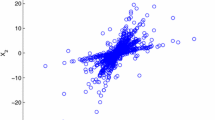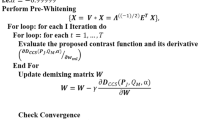Abstract
The contrast function remains to be an open problem in blind source separation (BSS) when the number of source signals is unknown and/or dynamically changed. The paper studies this problem and proves that the mutual information is still the contrast function for BSS if the mixing matrix is of full column rank. The mutual information reaches its minimum at the separation points, where the random outputs of the BSS system are the scaled and permuted source signals, while the others are zero outputs. Using the property that the transpose of the mixing matrix and a matrix composed by m observed signals have the indentical null space with probability one, a practical method, which can detect the unknown number of source signals n, ulteriorly traces the dynamical change of the sources number with a few of data, is proposed. The effectiveness of the proposed theorey and the developed novel algorithm is verified by adaptive BSS simulations with unknown and dynamically changing number of source signals.
Similar content being viewed by others
References
Hyvarinen A, Karhunen J, Oja E. Independent Component Analysis. New York: Wiley, 2001
Comon P. Independent component analysis—A new concept? Signal Processing, 1994, 36: 287–314
Amari S. Natural gradient works efficiently in learning. Neural Computation, 1998, 10(2): 251–276
Cardoso J F. Blind beamforming for non-Gaussian signals. IEE Proc-F, 1993, 140(6): 362–370
Hyvarinen A. Fast and robust fixed point algorithms for independent component analysis. IEEE Trans, Neural Network, 1999, 10(3): 626–634
Feng D Z, Zhang X D, Bao Z. An efficient multistage decomposition approach for independent component analysis. Signal Processing, 2003, 83(1): 181–197
Amari S, Cichocki A, Yang H H. A new learning algorithm for blind signal separation. In: Advances in Neural Information Processing Systems. Vol. 8. Cambridge: MIT Press, 1996. 757–763
Cardoso J F, Laheld H. Equivariant adaptive source separation. IEEE Trans Signal Processing, 1996, 44(12): 3017–3029
Karhunen J, Joutsensalo J. Representation and separation of signals using nonlinear PCA type learning. Neural Networks, 1994, 7(1): 113–127
Karhunen J, Pajunen P, Oja E. The nonlinear PCA criterion in blind source separation: Relations with other approaches. Neurocomputing, 1998, 22(1): 5–20
Pajunen P, Kathunen J. Least-squares methods for blind source separation based on nonlinear PCA. Int J Neural Systems, 1998, 8: 601–612
Zhu X L, Zhang X D. Adaptive RLS algorithm for blind source separation using a natural gradient. IEEE Signal Processing Letter, 2002, 9(12): 432–435
Zhu X L, Zhang X D, Ye J M. Natural gradient-based recursive least squares algorithm for adaptive blind source separation. Sci China Ser F-Inf Sci, 2004, 47(1): 55–65
Moreau E, Moreau N T. High-order contrasts for self-adaptive source separation. Int J Adaptive Control and Signal Processing, 1996, 10(1): 19–46
Yang H H, Amari S. Adaptive on-line learning algorithms for blind separation: Maximum entropy and minimum mutual information. Neural Comput, 1997, 9: 1457–1482
Cao X R, Liu R W. A general approach for blind source separation. IEEE Trans Signal Processing, 1996, 44(3): 562–571
Li Y Q. Sequential blind extraction of instantaneously mixed sources. IEEE Trans Signal Processing, 2002, 50(5): 997–1006
Thawonmas R, Cichocki A, Amari S. A cascade neural networks for blind extraction without spurious equilibria. IECE Trans Fundamental of Electronics, Communications and Computer Science, 1998, E81-A(9): 1833–1846
Cichocki A, Karhunen J, Kasprzak W, et al. Neural networks for blind separation with unknown number of sources. Neurocomputing, 1999, 24: 55–93
Thomas M, C, Joy A, T. Elements of Information Theory. New York: Weily, 1991, Chapter 9: 224–238
Ye J M, Zhu X L, Zhang X D. Adaptive blind source separation with an unknown number of source separation. Neural Computation, 2004, 16(8): 1641–1660
Zhang L Q, Cichocki A, Amari S. Natural gradient algorithm for blind separation of overdetermined mixture with additive noise. IEEE Signal Processing Letters, 1999, 6(11): 293–295
Zhang X D, Zhu X L, Bao Z. Blind source separation based on multistage decomposition. Sci in China Ser E-Tech Sci, 2002, 32(5): 693–703
Yang H H. Serial updating rule for blind separation derived from the method of scoring. IEEE Trans Signal Processing, 1999, 47(8): 2279–2258
Amari S, Chen T P, Cichocki A. Stability analysis of learning algorithms for blind source separation. Neural Networks, 1997, 10(8): 1345–1351
Author information
Authors and Affiliations
Corresponding author
Rights and permissions
About this article
Cite this article
Ye, J., Zhang, X. & Zhu, X. Blind source separation with unknown and dynamically changing number of source signals. SCI CHINA SER F 49, 627–638 (2006). https://doi.org/10.1007/s11432-006-2021-7
Received:
Accepted:
Issue Date:
DOI: https://doi.org/10.1007/s11432-006-2021-7




